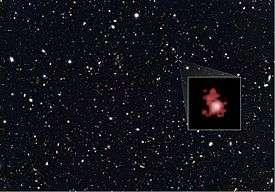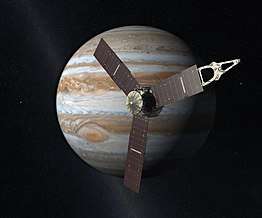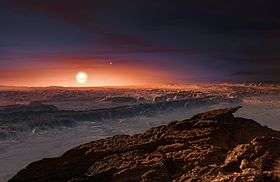469219 Kamoʻoalewa
469219 Kamoʻoalewa /kəˌmoʊ.oʊəˈlɛvə/,[6] provisional designation 2016 HO3, is a very small asteroid, fast rotator and near-Earth object of the Apollo group, approximately 41 meters (135 feet) in diameter. It is currently the smallest, closest, and most stable (known) quasi-satellite of Earth. The asteroid was discovered by Pan-STARRS at Haleakala Observatory on 27 April 2016. It was named Kamoʻoalewa, a Hawaiian word that refers to an oscillating celestial object.[1][2]
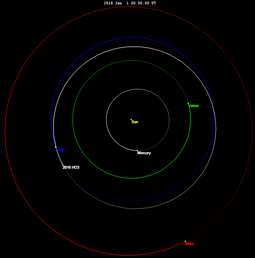 Orbit of Kamoʻoalewa in the inner Solar System | |
| Discovery [1] | |
|---|---|
| Discovered by | Pan-STARRS |
| Discovery site | Haleakala Obs. |
| Discovery date | 27 April 2016 |
| Designations | |
| (469219) 2016 HO3 | |
Named after | Kamoʻoalewa (oscillating celestial object) |
| 2016 HO3 | |
| Orbital characteristics [2] | |
| Epoch 27 April 2019 (JD 2458600.5) | |
| Uncertainty parameter 0 | |
| Observation arc | 14.07 yr (5,140 d) |
| Aphelion | 1.1048 AU |
| Perihelion | 0.8974 AU |
| 1.0011 AU | |
| Eccentricity | 0.1036 (~530 wrt Earth)[lower-alpha 1] |
| 1.00 yr (366 d) | |
| 202.35° | |
| 0° 59m 2.4s / day | |
| Inclination | 7.7816° |
| 66.249° | |
| 306.53° | |
| Earth MOID | 0.0333 AU (13.0 LD) |
| Physical characteristics | |
Mean diameter | |
| 0.467±0.008 h[lower-alpha 2] | |
| 0.20 (assumed)[5] | |
| S (assumed)[5] | |
Discovery and naming
Kamoʻoalewa was first spotted on 27 April 2016, by the Pan-STARRS 1 asteroid survey telescope on Haleakalā, Hawaii, operated by the University of Hawaii's Institute for Astronomy and funded by NASA's Planetary Defense Coordination Office.[1][4] The name Kamoʻoalewa is derived from the Hawaiian words ka 'the', moʻo 'fragment', referring to it being a piece broken off a larger object, a 'of', and lewa 'to oscillate', referring to its motion in the sky as viewed from Earth.[7][8] The official naming citation was published by the Minor Planet Center on 6 April 2019 (M.P.C. 112435).[9]
Orbit and classification
Kamoʻoalewa orbits the Sun at a distance of 0.90–1.10 AU once every 366 days. Its orbit has an eccentricity of 0.10 and an inclination of 8° with respect to the ecliptic.[2] It has an Earth minimum orbital intersection distance of 0.0348 AU (5,210,000 km) which translates into 13.6 lunar distances.[2]
Quasi-satellite of Earth
As it orbits the Sun, Kamoʻoalewa appears to circle (highly elliptically) around Earth as well. The object is beyond the Hill sphere of Earth and the Sun exerts a much stronger pull on it than Earth does. Although it is too distant to be considered a true natural satellite of Earth, it is the best and most stable example to date of a near-Earth companion, or quasi-satellite.[3]
"Since 2016 HO3 loops around our planet, but never ventures very far away as we both go around the Sun, we refer to it as a quasi-satellite of Earth", said Paul Chodas, manager of NASA's Center for Near-Earth Object (NEO) Studies at the Jet Propulsion Laboratory in Pasadena, California.[4]
One other asteroid – 2003 YN107 – followed a similar orbital pattern for a while over 10 years ago, but it has since departed our vicinity. This new asteroid is much more locked onto us. Our calculations indicate 2016 HO3 has been a stable quasi-satellite of Earth for almost a century, and it will continue to follow this pattern as Earth's companion for centuries to come.[4]
In its yearly trek around the Sun, asteroid 2016 HO3 spends about half of the time closer to the Sun than Earth is (that is, the asteroid is inside the Earth's orbit) and passes ahead of our planet, and about half of the time farther away (crosses outside Earth's orbit), causing it to fall behind. Its orbit is also tilted a little, causing it to bob up and then down once each year through Earth's orbital plane. In effect, this small asteroid is caught in a game of leap frog with Earth that will last for hundreds of years.[4]
The asteroid's orbit also undergoes a slow, back-and-forth twist over multiple decades. "The asteroid's loops around Earth drift a little ahead or behind from year to year, but when they drift too far forward or backward, Earth's gravity is just strong enough to reverse the drift and hold onto the asteroid so that it never wanders farther away than about 100 times the distance of the moon", said Chodas. "The same effect also prevents the asteroid from approaching much closer than about 38 times the distance of the moon. In effect, this small asteroid is caught in a little dance with Earth."[4] As of now, it has by far the most stable quasi-satellite of Earth discovered, in terms of orbit.
Physical characteristics
The size of Kamoʻoalewa has not yet been firmly established, but it is likely about 40–100 m (130–330 ft).[4] Based on an assumed standard albedo for stony S-type asteroids of 0.20 and an absolute magnitude of 24.3, it measures 41 meters (135 ft) in diameter.[5]
Photometric observations in April 2017 revealed that Kamoʻoalewa is a fast rotator. Lightcurve analysis gave a rotation period of 0.467 ± 0.008 hours (28.02 ± 0.48 minutes) and a brightness variation of 0.80±0.05 magnitude (U=2).[5][lower-alpha 2]
Proposed missions
During the 2017 Astrodynamics Specialist Conference held in Stevenson, Washington (US), a team composed by graduate research assistants from the University of Colorado Boulder and the São Paulo State University (UNESP) was awarded for presenting a project denominated "Near-Earth Asteroid Characterization and Observation (NEACO) Mission to Asteroid (469219) 2016 HO3", providing the first baselines for the investigation of this celestial object using a spacecraft.[10] [11] .[12] Recently, another version of this work was presented adopting different constraints in the dynamics. [13]
The China National Space Administration (CNSA) is planning a robotic mission that would return samples from 2016 HO3. This mission, ZhengHe, is planned for launch in 2024.[14][15]
Gallery

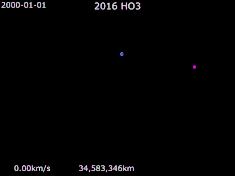
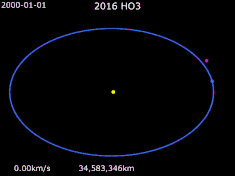
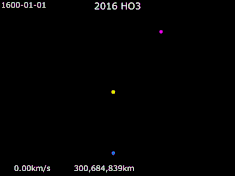
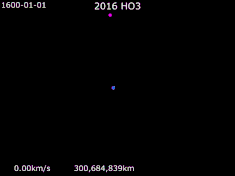
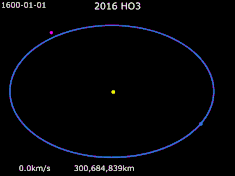
See also
- Arjuna asteroid
- Natural satellite
- Quasi-satellite
- 3753 Cruithne
- 6Q0B44E
- 2001 GO2
- 2002 AA29
- 2003 YN107
- 2006 JY26
- 2006 RH120
- 2012 FC71
- 2013 BS45
- (419624) 2010 SO16
- (436724) 2011 UW158
- 2002 VE68, a quasi-satellite of Venus, and the first quasi-satellite discovered around any major planet
Notes
- Computed with JPL Horizons using a geocentric solution. Ephemeris Type: Orbital Elements / Center: 500 / Time Span: 2017-Sep-04 (to match infobox epoch)
- Exceptional rotation period of 0.467 ± 0.008 hours (28.02 ± 0.48 minutes) with a brightness amplitude of 0.80±0.05 mag, quality code = 2, (Reddy 2018).[5] Not yet listed on ADS (November 2017). Summary figures at the LCDB.[5]
References
- "469219 (2016 HO3)". Minor Planet Center. Retrieved 9 April 2019.
- "JPL Small-Body Database Browser: 469219 (2016 HO3)" (2018-04-13 last obs.). Jet Propulsion Laboratory. Retrieved 9 April 2019.
- de la Fuente Marcos, C.; de la Fuente Marcos, R. (November 2016). "Asteroid (469219) 2016 HO3, the smallest and closest Earth quasi-satellite". Monthly Notices of the Royal Astronomical Society. 462 (4): 3441–3456. arXiv:1608.01518. Bibcode:2016MNRAS.462.3441D. doi:10.1093/mnras/stw1972.
- Agle, DC; Brown, Dwayne; Cantillo, Laurie (15 June 2016). "Small Asteroid Is Earth's Constant Companion". Jet Propulsion Laboratory. Retrieved 19 November 2017.
- "LCDB Data for (469219)". MinorPlanet.Info — ALCDEF Query. Asteroid Lightcurve Database (LCDB). Retrieved 19 November 2017.
- He Noiʻi Nowelo i ka ʻIke Kuʻuna Hawaiʻi o ka ʻŌnaeao, imiloahawaii.org, retrieved 2019-10-13
- ulukau HAWAIIAN ELECTRONIC LIBRARY
- "MPC/MPO/MPS Archive". Minor Planet Center. Retrieved 9 April 2019.
- Venigalla, C; Baresi, N; Aziz, J; Bercovici, B; Borderes Motta, G; Brack, D; Cardoso dos Santos, J; Dahir, A; Davis, A B; Smet, S D; et al. (2019). "Near-Earth Asteroid Characterization and Observation (NEACO) Mission to Asteroid (469219) 2016 HO3" (PDF). Advances in the Astronautical Sciences, V. 162, 34 P., 2018. 56 (4): 1121–1136. Bibcode:2019JSpRo..56.1121V. doi:10.2514/1.A34268. Retrieved 11 November 2019.
- Venigala, C; et al. (September–October 2017). "STUDENT DESIGN COMPETITION" (PDF). Space Times Magazine. Retrieved 11 November 2019.
- Cardoso dos Santos, J; Borderes Motta, G (March 2018). "Alunos da Unesp vencem competição internacional". UNESP Notícias (Portuguese). Retrieved 11 November 2019.
- Venigalla, C; Baresi, N; Aziz, J; Bercovici, B; Brack, D; Dahir, A; Davis, A B; Smet, S D; et al. (February 2019). "Near-Earth Asteroid Characterization and Observation (NEACO) Mission to Asteroid (469219) 2016 HO3". Journal of Spacecraft and Rockets. 56 (4): 1121–1136. Bibcode:2019JSpRo..56.1121V. doi:10.2514/1.A34268.
- Gibney, Elizabeth (30 April 2019). "China plans mission to Earth's pet asteroid". Nature. doi:10.1038/d41586-019-01390-5. Retrieved 30 April 2019.
- Zhang, Xiaojing; Huang, Jiangchuan; Wang, Tong; Huo, Zhuoxi (18–22 March 2019). ZhengHe – A Mission to a Near-Earth Asteroid and a Main Belt Comet (PDF). 50th Lunar and Planetary Science Conference. Retrieved 20 June 2019.
External links
- 2016 HO3 at NeoDyS-2
- Asteroid 2016 HO3 - Earth's Constant Companion NASA Jet Propulsion Laboratory, 23 June 2016
- Asteroid Lightcurve Database (LCDB), query form (info)
- Discovery Circumstances: Numbered Minor Planets (465001)–(470000) – Minor Planet Center
- 469219 Kamoʻoalewa at NeoDyS-2, Near Earth Objects—Dynamic Site
- Ephemeris · Obs prediction · Orbital info · MOID · Proper elements · Obs info · Close · Physical info · NEOCC
- 469219 Kamoʻoalewa at the JPL Small-Body Database

